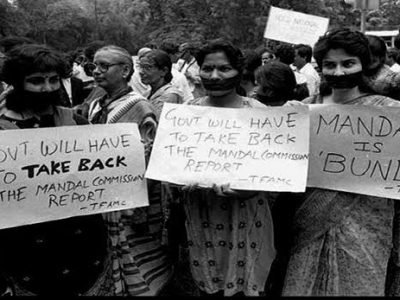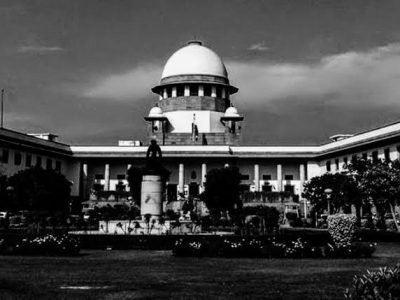Co-Authors: Abhishek Singh and Aditi Raj, 1st year students in NUSRL, Ranchi.
LORD RAM’S BIRTHPLACE (RAM JANAMBHOOMI)
Lord Ram is one of the Hindu Deity, who, according to the Ramayana was born in Ayodhya to Kaushalya and Dashrath, somewhat at the time of Treta Yug. Many stories can be heard revolving around Lord Ram’s adventures, his heavenly qualities and intelligence. Furthermore, Ayodhya is believed to be one of the seven places where Moksh, i.e., Salvation can be availed. Some old texts contain mentions such as Lord Ram’s Janamsthan, Ramdurg (Lord Ram’s fort). All the above mentions can be traced in The Ramayana, The Garuda Purana and The Ayodhya Mahatmya.
MOSQUE OF BABUR
The first Mughal ruler and founder of Mughal empire was Babur. According to some beliefs, one of his generals built the Masjid on Babur’s orders during the year 1528. The belief came into notice during 1814 while Francis Buchanan was recording the local traditions, which stated that the Mosque was built by Aurangzeb after demolishing the temple devoted to Lord Ram.
It is to be noted that during the years 1528 – 1688, there were no mentions of the Mosque. It first came into light when Jai Singh II, a Rajput, bought the land on which the Mosque was built along with the surrounding land during the year 1717. The documents belonging from that period showed a three-domed structure considered to be a Mosque but labelled as birthplace. A Chabutra (or Courtyard) is indicated where Hindu devotees are seen worshipping the deity.
There is no mention to be found in The Baburnama or his grandson i.e., Akbar’s records nor in Akbar’s Hindu poet, Tulsidas’s epic Ramcharitramanas, which is dedicated to Lord Ram. It is believed that both the Hindu’s and the Muslims worshipped at the site. The Hindus used to worship outside the structure and the Muslim’s inside it. To prevent any quarrel, railings were introduced inside the premises during the year 1857. It was during the year 1947, when an idol of Lord Ram was found placed inside the Mosque, leading to clashes between both the sides.
DEMOLITION OF THE BABRI MOSQUE
On 6 Dec, 1992 the demolition of Babri Masjid took place. A crowd of 1.5 lac people were present at the site to listen to the speeches delivered by BJP and VHP leaders and later stormed into the Mosque and destroyed it in a matter of hours.
The following evening, the Karsevaks attacked on muslims residing in Ayodhya, lit their houses on fire and ransacked them. FIRs were filed against unknown Karsevaks, BJP and VHP leaders on the grounds of provocation. A series of attacks on both the Hindus and the Muslims took place from time to time, resulting in the deaths of numerous innocent Indians.
In Oct 1993, the CBI took over the case which was filed against the BJP and VHP leaders, along with 19 other people for conspiracy, spreading hatred and causing demolition of the said structure.
The Centre acquired 67 acres of land in and around the Mosque under the ‘Acquisition of Certain Area at Ayodhya Act’ which was passed during the following year only.
In May 2001, as the NDA backed government came to power, proceedings against BJP and VHP were dropped and the said leaders were cleared of cases related to conspiracy, inciting hatred and provocation which resulted in the demolishing of the Mosque.
THE ALLAHABAD HIGH COURT VERDICT
On 30 Sept, 2010 a three-judge bench with a majority of 2:1, held that 2.77 acres disputed land will be divided into three parts and given to each party, i.e. One-third for the Nirmohi Akhara, One-third for the Sunni Waqf Board and One-third for ‘Ram Lalla’ represented by Hindu Maha Sabha. Since none of the party were able to establish title over the disputed land in Ayodhya by the way of evidence and documented support, division of the land seemed like the only way of handing over the possession of the land.
The dissenting judge held that “No temple was demolished for constructing the mosque. Mosque was constructed over the ruins of temples which were lying in utter ruins since a very long time before the construction of mosque and some material thereof was used in construction of the mosque”.
None of the parties accepted this judgment and appealed in the Supreme Court challenging the judgement.
THE SUPREME COURT VERDICT
The Supreme Court (SC) started to hear the case from 6 Aug 2019 to 16 Oct 2019. After a continued hearing of the case for 40 days, the final judgment was declared on 9 Nov 2019 at 10:30 Am, which went on for 45 minutes.
The SC entrusted the land to a trust to build the Temple and ordered the government to provide The Uttar Pradesh Sunni Central Waqf Board an alternate 5 acres of land at a prominent site for the purpose of building the Mosque.
The Nirmohi Akhara’s suit was barred by limitation because it was not a shebait or devotee of the deity.
On 12 Dec 2019 the SC dismissed all the petitions which were seeking review of the verdict.
SOCIAL IMPACT
In 1992, when Babri mosque was demolished, there were inter communal rioting across the whole country and curfew was initiated in many cities. However, the situation was quite different when the Supreme Court pronounced the judgment to one of the longest disputes in India and put an end to it. This was contrary to what was expected, as many security and riot control measures were set up in anticipation of the long-awaited judgement.
The Sunni Waqf Board announced soon after the judgement, its decision to not file a review petition and thus it accepts the Supreme Court judgement.
The judgment was celebrated by the Hindus community. Many positive comments welcoming the judgement were made by prominent Hindus leaders such as L. K. Advani and Jagat Prakash Nadda. PM Modi also made a speech welcoming the judgement and said that the Supreme Court has bought a new dawn for us and that this decision gave us a lesson to move forward.
Some arrests were made based on social Media posts but overall, the whole situation remained calm. Something that was quite different to the situation in 1992, when the country was engulfed in intercommunal violence.
There is an atmosphere of fear among the opponents, not about themselves, but fear for the country. They think that the SC in passing this judgment has not acted in the way it should. They think that the justice system of the country is under threat from the political powers.To oppose the verdict, they even suggested boycotting the awarded 5-acre land. According to the opponents, the decision will play a vital role in giving false confidence to the proponents, thinking large scale communal violence may occur in the near future.
They are also disappointed because of the lack of sympathy shown to them by the court “If SC has done justice then why are they giving us a substitute piece of land?”
They say that if the breaking down of mosque was illegal, why were the goons not punished? In such allotment of land, the court has performed its compensatory function which might just fall short of complete justice. The proponents seem to have forgotten about the demolition of the mosque.
PROPONENTS OF THE VERDICT
According to those who are in favour of the verdict, the SC has undone a misdeed which is a very commendable work according to them.
● They are of the view to maintain peace and are also calling for acceptance of the SC verdict. They are of the opinion that this is an internal matter and no one besides an Indian need to comment on the judgment.
● Accordingly, they are saying that the matter has taken the shape of politics which was not beneficial for either side. The slogan of ‘Ek Bharat, Shrestha Bharat’ is flowing in the air.
● They claim that this judgment has proven that any dispute can be solved with apt fairness. According to them, this judgment is pronounced without any fear or favour.
● The judgment reaffirms transparency, farsightedness and independence of the judiciary. They also said that the judgment shouldn’t be considered as a victory or defeat. The proponents are trying to spread peace and harmony.
Timeline
1528– According to the engravings embedded in the Masjid’s walls, the Babri Masjid was constructed on commands of Babur. However, Hindus alleged that it was Lord Ram’s birthplace and had a temple on it which was destroyed by Babur.
1611– A merchant from England, William Finch, signifies facts about Lord Ram’s palace being visited by devotees.
1717– A Rajput named Jai Singh II purchased the land and placed Lord Ram’s idol in it
1853 – First clashes were recorded at the site.
1857– Fencing of the site, separated places of worship for both The Hindu and The Muslim community
1949– Idol found placed in the Mosque. Civil suits were filed on plot number 583. Closure of Mosque’s gates.
1961– Filing of case in The Indian courts.
1984– Uproar in The Hindus to build the temple on Lord Ram’s Janambhoomi (birthplace). Increase in momentum of Hindus.
1986 -A district judge allows opening of the gates for worshipping on the plea of Hari Shanker Dubey. Formation of The Babri Masjid committee.
1989 – New case was filed by Deoki Nandan Agarwala, Vishwa Hindu Parishad Vice President. Laying of foundation of A temple near the site. Clashes recorded in Bhagalpur.
1990 – VP Singh elected as Prime Minister with the support of BJP. A Yatra organized by BJP leader L K Advani. On his arrest the BJP takes back its support. With the support of congress, Chandra Shekhar was appointed as new prime minister. Karsevkas were gunned down, their bodies thrown in the Sarayu river.
1991– BJP comes to power, with Kalyan Singh as The Chief Minister of Uttar Pradesh.
1992– This proved to be a turning point for Hindu organizations namely VHP and Shiv Sena who razed the Mosque. This resulted in the spreading of communal violence in which more than 2000 people were killed.
2001– Tensions escalate as VHP vouches to build the temple on the site.
2002 – 58 people were killed in Gujarat. Three high court judges of Allahabad began the hearing regarding ownership of the site.
2003 – Several Hindu leaders, along with some prominent BJP leaders stood for trials.
2010 – A three-judge bench of Allahabad high court parts 2.77 acres of land in 3 pieces in the ratio of 2:1. 2 parts for Hindus and 1 for Muslims.
2011 – A stay on the verdict. Status quo to remain.
2019– Constitution of a mediation panel, headed by F M Khallifula. A five-judge bench was also constituted, headed by the then Chief Justice of India Ranjan Gogoi. Other judges were Justices Sharad Arvind Bobde, Dhananjaya Yeshwant Chandrachud, Ashok Bhushan and Abdul Nazeer. The 70-year long case comes to a halt with orders of construction of the Temple and allotting 5 acres of land for the mosque at another location.
The 70-Year Long Case Comes To An End With Orders Of Construction Of The Temple And Alloting 5 Acres Of Land For The Mosque At Other Location.






